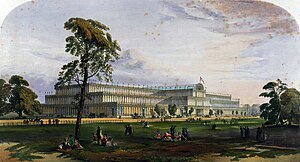Royal Commission for the Exhibition of 1851
The Royal Commission for the Exhibition of 1851 is an institution founded in 1850 to administer the Great Exhibition of the Works of Industry of all Nations, which was held in The Crystal Palace, London.

The founding President of the Commission was Prince Albert of Saxe-Coburg and Gotha and its chief administrator was Henry Cole. The current President is Anne, Princess Royal.
The exhibition was a popular and financial success, with a surplus of £186,000 (equivalent to £25,720,000 in 2023). An unusual decision was made to maintain the Royal Commission as a permanent administrative body and to use the profits for charitable purposes. Its revised charter charged the commission with "increasing the means of industrial education, and extending the influence of science and art upon productive industry".
South Kensington
[edit]The commission invested the profits from the 1851 Exhibition in the purchase of 86 acres (350,000 m2) of land in South Kensington. The area was then developed as a centre for educational and cultural institutions, often known as "Albertopolis". These include:
- Imperial College
- the Natural History Museum
- the Royal Albert Hall
- the Royal College of Art
- the Royal College of Music
- the Science Museum
- the Victoria and Albert Museum
The commission's headquarters are in Imperial College.
Since 1891 the role of the commission has been to provide postgraduate scholarships for students to study in Britain and abroad. Former recipients of scholarships include 13 Nobel Prize laureates.
The commission currently[when?] has capital assets of more than £76 million and makes charitable disbursement of more than £2 million a year.[citation needed]
References
[edit]Further reading
[edit]- Hobhouse, Hermione (2002). The Crystal Palace And the Great Exhibition: Science, Art And Productive Industry: The History of the Royal Commission for the Exhibition of 1851. London: Continuum International Publishing Group. ISBN 978-0-485-11575-8.
